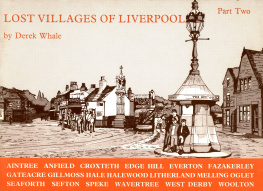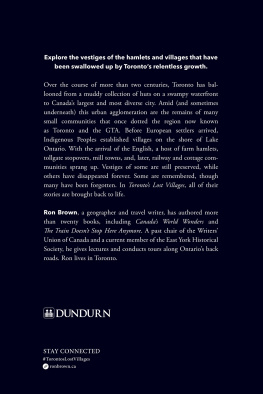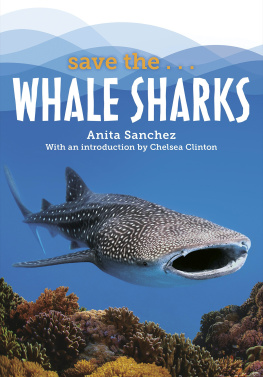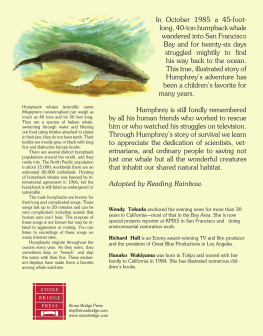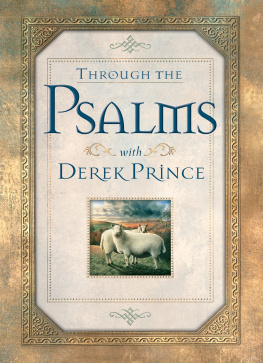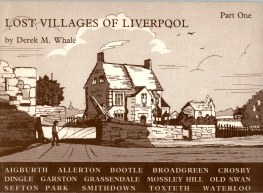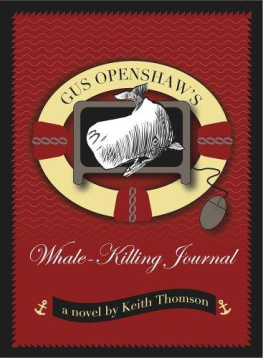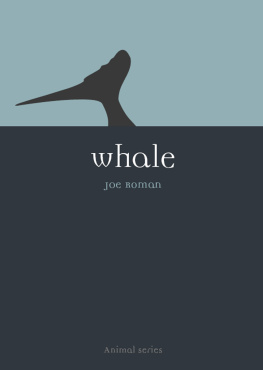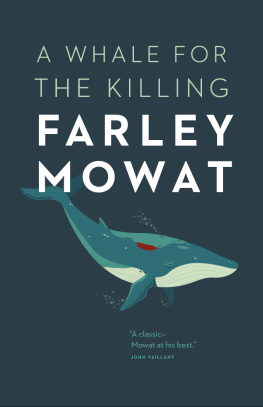Derek Whale - Lost Villages of Liverpool
Here you can read online Derek Whale - Lost Villages of Liverpool full text of the book (entire story) in english for free. Download pdf and epub, get meaning, cover and reviews about this ebook. year: 1984, publisher: T.Stephenson & Sons Ltd, genre: Non-fiction. Description of the work, (preface) as well as reviews are available. Best literature library LitArk.com created for fans of good reading and offers a wide selection of genres:
Romance novel
Science fiction
Adventure
Detective
Science
History
Home and family
Prose
Art
Politics
Computer
Non-fiction
Religion
Business
Children
Humor
Choose a favorite category and find really read worthwhile books. Enjoy immersion in the world of imagination, feel the emotions of the characters or learn something new for yourself, make an fascinating discovery.
- Book:Lost Villages of Liverpool
- Author:
- Publisher:T.Stephenson & Sons Ltd
- Genre:
- Year:1984
- Rating:5 / 5
- Favourites:Add to favourites
- Your mark:
- 100
- 1
- 2
- 3
- 4
- 5
Lost Villages of Liverpool: summary, description and annotation
We offer to read an annotation, description, summary or preface (depends on what the author of the book "Lost Villages of Liverpool" wrote himself). If you haven't found the necessary information about the book — write in the comments, we will try to find it.
Lost Villages of Liverpool — read online for free the complete book (whole text) full work
Below is the text of the book, divided by pages. System saving the place of the last page read, allows you to conveniently read the book "Lost Villages of Liverpool" online for free, without having to search again every time where you left off. Put a bookmark, and you can go to the page where you finished reading at any time.
Font size:
Interval:
Bookmark:
We hope you have enjoyed Lost Villages of Liverpool Part Two. Part Three will be published shortly.
Part One includes:
Aigburth, Allerton, Bootle, Broadgreen, Crosby, Dingle, Garston, Grassendale, Mossley Hill, Old Swan, Sefton Park, Smithdown, Toxteth & Waterloo.
Part Three will include:
Calderstones, Childwall, Clubmoor, Dovecot, Huyton, Kirkby, Kirkdale, Knotty Ash, Knowsley, Newsham, Roby, Simonswood, Thingwall, Tuebrook, Prescot & Walton.
Please telephone 051-426 5161 to check the availability and prices.
To all lovers of old Liverpool and those who may still have much to learn about the history and heritage of the districts in which they live or have known.
I have tried to keep within the boundaries of the areas mentioned and which are generally known by the names given.
However, because borders are somewhat tenuous, occasional incursions into neighbouring territory have occurred here and there, sometimes to link places and events.
This book includes:
Aintree, Anfield, Croxteth, Edge Hill, Everton, Fazakerley, Gateacre, Gillmoss, Hale, Halewood, Litherland, Melling, Oglet, Seaforth, Sefton, Speke, Wavertree, West Derby, Woolton.
For contents of Parts One & Three please see inside back cover.
The cover is a reproduction of a photograph of West Derby village, about 1896, showing horse-tram terminus and monument (left) marking site of ancient Chapel of St. Mary the Virgin.
The author thanks the copyright holders of the photographs and illustrations used in this book particularly the Daily Post and Echo and also those whom it has not been possible to trace.
ISBN 0 901314 25 0
Derek Whale 1984 PRINTED BY T. STEPHENSON & SONS LTD., PRESCOT, MERSEYSIDE.
Aintree, Ayntree or Ayntre, as this district was sometimes written in ancient documents, means "One Tree," and is taken from the Anglo-Saxon "an-treow." Why there should be such a relatively large area, so close to the heavily-forested West Derby, about 1,000 years ago, with only one tree, seems to be a mystery today. However, in the far future, Aintree's flat and open landscape proved to be a bonus for it not only became an important place for horse-racing but also for flying, and a number of pioneer flights were made from here.
The whole world, of course, knows that Aintree is the home of the Grand National. Not so many, however, would know that there was horse racing on the flat in this area when Elizabeth I was on the throne. Steeple-chasing was introduced at nearby Maghull in 1837 (when Victoria came to the throne) and, two years later, on February 26, the Grand National, then known as the Liverpool Grand Steeple Chase, was run at Aintree.

A sketch of the inauguration of the most famous horse race in the world - the Grand National, although in 1839, when the race was held at Aintree, it was called the Liverpool Grand Steeple Chase. The runners are seen here tackling the cruel real stone wall. During this race, Captain Becher, on Conrad, tumbled into a brook obstacle, which from then on was always known as Becher ys Brook. The race zvas won by Lottery, whose jockey was named Mason.
It was chiefly through the efforts of William Lynn, sporting proprietor of the Waterloo Hotel, Liverpool, that the 'chase venue was transferred in 1839 to Aintree. He was supported by a syndicate of the Earls of Derby, Sefton, Eglington and Wilton, Lord George Betlinck, Lord Stanley, Lord Robert Grosvenor and seven other well-known northern sportsmen. The race was handicapped in 1843 and renamed Grand National Steeple Chase.
The first stone of the grandstand at the new Aintree Racecourse was laid by Lord Molyneux on February 7,1829, and the first races there took place on July 7, the same year.
All roads seemed to lead to Aintree that week and the highways were crowded with traffic, from stylish carriages-and-four to humble shandrydans and, of course, thousands of equestrians and pedestrians.
According to the Liverpool Weekly Mercury: "The canal also furnished its quota of visitors from Liverpool, Ormskirk, Wigan and etc., and flats, packets and fly-boats, decorated with streamers and enlivened by bands of musicians came freighted with the lovers of sport. On Tuesday (opening day) there could not have been fewer than thirty to forty thousand persons on the ground".
The first race to be run on the new course was the 1 1/4-mile Croxteth Stakes, won by Mufti, owned by Mr. Francis.
For 70 years there was a red-brick county police station at the entrance to Aintree Racecourse. This was closed in October, 1965, and demolished to make way for an extension of the dual carriageway of the main Liverpool-Preston road.
Long before Speke and Hooton became aerodromes for flying displays, old-time fliers would unpack their crated, flimsy aircraft at Aintree Racecourse, put them together and thrill Merseysiders with their daring flights sometimes to be measured in only yards! In November 1909, when flying was still very much in its infancy, the Daily Post and Mercury encouraged those "daring young men in their flying machines" and supported flying demonstrations there.
Sir William Pickles Hartley, the famous jam manufacturer with the large factory at Aintree, offered a 1,000 prize for the first flight from Liverpool to Manchester. Ace aviator Colonel Samuel Cody (not related to Buffalo Bill), who brought his bi-plane in sections from Doncaster, nearly won this prize. He got as far as Eccles ton Park, only ten miles from the city, but with fog preventing his seeing obstructions (like telegraph poles and wires), he was compelled to return. There were no such things as instrument-landings, talk-downs and sophisticated aids to navigation in those days, when one virtually "flew by the seat of his pants".
The famous Liverpool pioneer airman, Henry G. Melly, made it in 1911. He flew to Manchester in 49 minutes and back in 65 minutes on July 7. Henry was accompanied by his wife, Ellen, who is thought to have been the first woman to fly in Britain (other than balloonists).
Other pilots who gave public exhibitions of flying in their weird and wonderful planes at that time included the Rev. Sidney Swann, Rector of Crosby, Ravensworth, a former Cambridge rowing blue, in a monoplane designed by himself and constructed by the Austin Motor Company. Brazilian Alberto Santos Dumont, the first man to fly an aeroplane in Europe, in 1906, flew his 6V2 cwt. "La Demoiselle". Mr. James More, the Scottish pilot and racing driver, had a Voisin bi-plane, like those also owned by Messrs. Simpson and Cockburn.
But Cody seemed to be the favourite. He flew a bi-plane with a three-wheeled undercarriage and a wheel under each wing. On his first flight he managed to cover only three miles before making a forced-landing in a ploughed field at Melling, 500 yards from the railway station. Cody immediately telephoned his helpers at Aintree and said: "All's well. Landed at Melling. Send two sparking plugs." Two of the aircraft's five wheels were buckled when he again crash-landed on his return to Aintree.
During the following Great War, aircraft were considerably improved and numerous Bristol planes were turned out at Aintree's National Aircraft Factory, which had its own landing field, nudging the racecourse. From this field, on April 30, 1924, the Belfast-Liverpool airmail service was inaugurated.
It was operated by De Havilland 50's of that company's aeroplane-hire service, and crack flier Mr. (later Sir) Alan Cobham piloted the first aircraft from Belfast (Malone) to Liverpool (Aintree). He brought with him the Lord Mayor of Belfast (Aid. Sir W. Turner) and the High Sheriff (Councillor M. C. McLaurin), and waiting at Aintree to greet them at 2.40 p.m. were Sir Archibald Salvidge, deputising for the Lord Mayor; Mr. F. C. Wilson and the Town Clerk, Mr. Walter Moon. The weather was bad, with rain and mist, and the flight took 2 hours 20 minutes. But Cobham made the return flight at 5.30 p.m., via Southport sand (to pick up newspapers) in only two hours. The aircraft carried four passengers (fares were 3 single). They cruised at 95 m.p.h. and had a range of 380 miles. An aircraft left Liverpool at 5.15 a.m. and Belfast at 6.20 p.m., on this daily service. Letters from Belfast were delivered in Liverpool the same evening and in London and provincial towns, the next morning. Poor weather conditions at that time, and sparse aerodrome facilities, caused this service to be cancelled. It finished on June 2, 1924.
Next pageFont size:
Interval:
Bookmark:
Similar books «Lost Villages of Liverpool»
Look at similar books to Lost Villages of Liverpool. We have selected literature similar in name and meaning in the hope of providing readers with more options to find new, interesting, not yet read works.
Discussion, reviews of the book Lost Villages of Liverpool and just readers' own opinions. Leave your comments, write what you think about the work, its meaning or the main characters. Specify what exactly you liked and what you didn't like, and why you think so.

